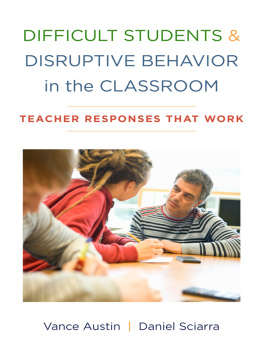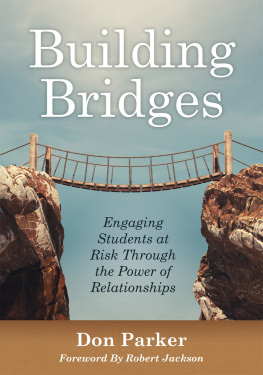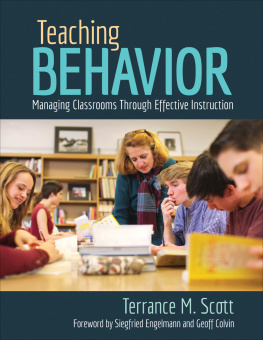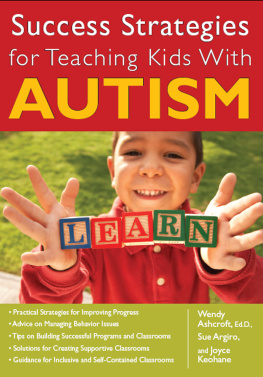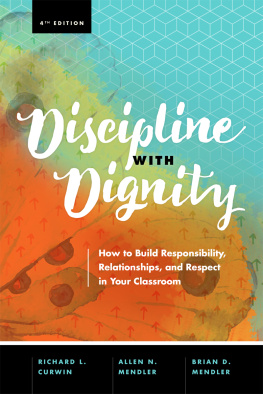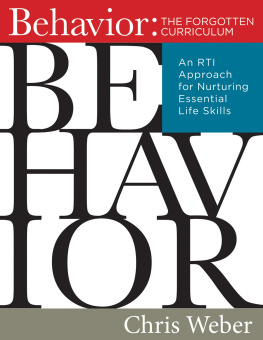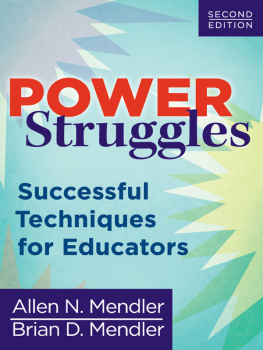
DIFFICULT STUDENTS &
DISRUPTIVE BEHAVIOR
in the CLASSROOM
NORTON BOOKS IN EDUCATION

Note to Readers: Models and/or techniques described in this volume are illustrative or are included for general informational purposes only; neither the publisher nor the author(s) can guarantee the efficacy or appropriateness of any particular recommendation in every circumstance.
Copyright 2016 by Vance Austin and Daniel Sciarra
All rights reserved
First Edition
For information about permission to reproduce selections from this book, write to Permissions, W. W. Norton & Company, Inc., 500 Fifth Avenue, New York, NY 10110
For information about special discounts for bulk purchases, please contact W. W. Norton Special Sales at specialsales@wwnorton.com or 800-233-4830
Production manager: Christine Critelli
Jacket design by Lauren Graessle
Jacket photo echo/Getty Images
The Library of Congress has cataloged the printed edition as follows:
Names: Austin, Vance
L., author. | Sciarra, Daniel T., author.
Title: Difficult students and
disruptive behavior in the classroom : teacher
responses that work /
Vance Austin, Daniel Sciarra.
Description: First edition. | New York :
W.W. Norton & Company, 2016. |
Series: Norton books in education | Includes
bibliographical references
and index.
Identifiers: LCCN 2015047524 |
ISBN 9780393707540 (pbk.)
Subjects: LCSH: Classroom managementUnited
States. | Problem
childrenUnited StatesDiscipline. | School
disciplineUnited States.
Classification: LCC LB3013 .A87 2016 | DDC
371.102/4dc23 LC record available at http://lccn.loc.gov/2015047524
ISBN: 978-0-393-70754-0 (pbk.)
ISBN 978-0-393-71202-5 (e-book)
W. W. Norton & Company, Inc., 500 Fifth Avenue, New York, N.Y. 10110
www.wwnorton.com
W. W. Norton & Company Ltd., 15 Carlisle Street, London W1D 3BS
To my wife Theresa and son James who have given my life meaning and fulfillment; to my brother, Tim, for loving kindness that defies time and space, and to my mother, Lois, for everything...
VA
To the children of the Child Guidance Center of Southern Connecticut whose lives taught me the importance of attachment.
DS
We would like to thank Deborah Malmud, Vice President and Director of Norton Professional Books, for getting us started on this project and for her encouragement and support along the way. Likewise, we offer very special thanks to Ben Yarling, Associate Editor, Norton Professional Books, who was able to share our vision for this project and see beyond the developmental imperfections and appreciate its contribution to the field. Similarly, we would like to thank Alison Lewis, Marketing and Editorial Assistant at Norton Professional Books, whose patience, focus, and attention to detail helped us move more efficiently to production. Also, we would be remiss if we did not acknowledge the generous support provided by Elizabeth Baird, our Project Editor, as well as the exceptional work of our copy editor, Rebecca Caine, whose meticulous editing contributed significantly to the coherence and accuracy of our manuscript.
Finally, we would like to thank our family members, Brenda, Theresa, and James, whose unconditional love, patience, and encouragement made the completion of this project both possible and worthwhile.
A s the inclusive classroom continues to develop into standard practice throughout the United States, classroom teachers can no longer claim that students with special needs and behavioral challenges are not their responsibility. Frequently, within the inclusion model, special and general educators are paired to serve students with a variety of needsgifted, average, learning disabled, and emotionally disturbedin a single classroom. As a result, all teachers must now acquire the skills and dispositions necessary to effectively teach students with a wide variety of needs. Teacher preparation programs and schools must find ways to ensure that preservice and novice teachers are prepared to address the increasingly diverse needs of all students assigned to their classrooms. As one step in the reflective process of teacher preparation and professional development practices, the effective behaviors of successful teachers need to be considered.
In discussing the needs of some of the most challenging students, Cavin encouraged teachers to remember that these kids with all of their problems, their criminal records, their probation officers, their idiosyncrasies, their unlovable characteristics, and their strange families are still kids. They need someone to care. They need someone to accept them. They need to know they are somebody. If you are willing to provide these ideals, you can be the connection that bridges the gap from drop-out to diploma (1998, p. 10).
A further incentive to stay the course with challenging students was provided by a former colleague, who observed, For some kids, these days in school may be the best of their lives: the safest, the happiest, and the most secure. We never forgot this insightful pronouncement, and it helped change our attitudes about teaching even the most oppositional, defiant students.
A final inducement to persevere with difficult students comes from recent data provided by the U.S. Office of Juvenile Justice. In 2010, according to their records, 70,792 juveniles were incarcerated in the United Statesthe greatest number worldwide. In fact, the incarceration rate for juveniles (school-age children) in the United States in 2002 was 336 for every 100,000 youthcompare that figure to the country with the next-highest rate, South Africa, with 69 of every 100,000 youth in detention (as cited in Mendel, 2011). In response to these abysmal statistics and his own extensive experience, DeMuro, the former commissioner of the Pennsylvania Juvenile Corrections system, described the current state of juvenile justice in the United States as iatrogenic (as cited in Mendel, 2011). Mendel (2011) noted further that while education and treatment at most juvenile detention facilities is nonexistent, the average annual cost to house an incarcerated youth in a detention facility is approximately $88,000, whereas the cost to provide that same individual with effective intervention services in a public or specialized school is approximately $10,000 to $15,000. Moreover, the recidivism rate for incarcerated youth in New York State three years or more after release ranges from 73% to 89% (Annie E. Casey Foundation, 2011).
Similarly, a 2006 investigation revealed that only 33% of youth who said they would return to school once released from a Pennsylvania corrections camp program actually did so (Hjalmarsson, 2008). Since there are, effectively, no rehabilitation programs in most juvenile corrections facilities, youths detained in them can actually become more antisocial and more inclined to engage in criminal behaviors after their release. Thus, the data clearly suggest that the last, best hope for most of these at-risk youth is in schooland perhaps the best models of prosocial behavior are their teachers.
A F RAMEWORK FOR G OOD T EACHING
After reviewing the relevant literature concerning the elements common to most good teachers, we have identified three fundamental factors: (1) relationship building, (2) pedagogical skills, and (3) subject knowledge, in that order.
Relationship Building
What is meant by relationship as it pertains to teachers and students? Simply put, the term refers to the rapport the teacher builds with the studenta connection that fosters trust and that facilitates learning. Truth be told, such meaningful and affirming relationships are the reasons most teachers want to teach in the first place. Good teacherstudent and studentteacher relationships are often the reason that students choose to stay in school, acquire an affinity for a particular subject, feel good about their school experience, look forward to coming to class, and report feeling a sense of self-efficacy. Teacherstudent relationships, like any other human relationship, can be either healthy and reciprocally validating or unhealthy and destructive. Boynton and Boynton (2005) note that students are more likely to do what teachers ask when they feel valued and cared for by them. Similarly, Thompson stated that the most powerful weapon available to [teachers] who want to foster a favorable learning climate is a positive relationship with our students (1998, p. 6), and Canter and Canter (1997) suggested that students who enjoy a positive relationship with their teachers will be more inclined to comply with their requests and work conscientiously on assignments.
Next page
